- Print This Page
- Text Size
- Scroll To Top
Click here to join our mailing list

Click here for Regatta Wrap-up Video

Click here to watch Harken's - A Love Letter to the E Scow!

Fun Gary Jobson video
discussing our centennial achievement!
https://www.youtube.com/watch?v=gXjFCoX8Hq4

Click here for the NEW E Scow Tutorial Video Series

Click here!

Send content for posting to: [email protected] Click on the images below to see our Social Media Sites:
View this profile on Instagram National E Scow Class (@ e_scow ) • Instagram photos and videos
- AROUND THE SAILING WORLD
- BOAT OF THE YEAR
- Email Newsletters
- Best Marine Electronics & Technology
- America’s Cup
- St. Petersburg
- Caribbean Championship
- Boating Safety


The Enduring E Scow
- By Gary Jobson
- Updated: October 26, 2021
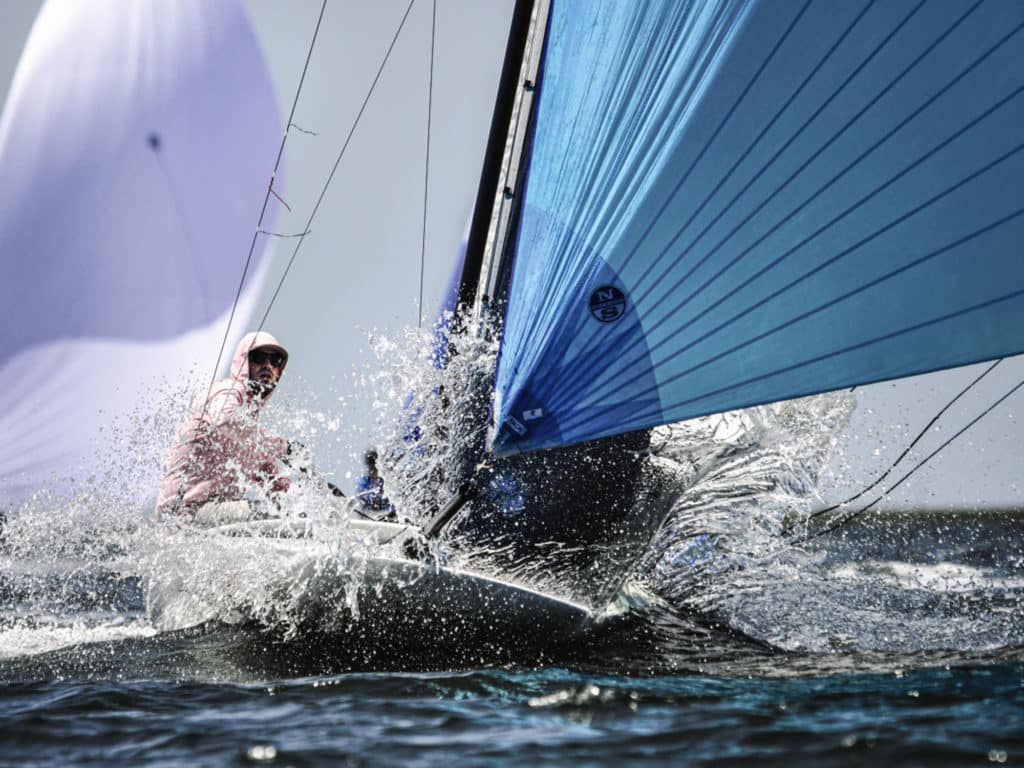
As the wind builds to 20 knots, eager crews on board 56 E Scows inch toward the starting line, sails flapping noisily. The race committee’s air horn sounds the start, and the fleet lurches forward, a densely packed swarm of white sails and low-slung surfboardlike hulls. But then there’s another horn. It’s a general recall, and the fleet returns to the line one by one. For its second attempt at a clean start, the race committee takes drastic action and hoists the dreaded black flag. Like scolded children, the fleet behaves, and five minutes later, 216 sailors shoot across the line toward the first mark of the course. New Jersey’s Little Egg Harbor is a choppy mess, which makes it tough-going on these flat-bottom scows. In less than two minutes, there’s a clear divide between the front and back half of the fleet. The faster teams surge into the lead, while the slower boats swiftly trail behind.
Among the front-runners in this race is 20-year-old Harry Melges IV, who had been penalized with a black-flag disqualification the previous day. Understandably, he is hoping for at least six races so he can discard his BFD score. Melges and his young crew of Kyle Navin, Finn Rowe and Ripley Shelley are sailing fast. They find a clean lane and round the first mark in third, setting the asymmetric spinnaker and accelerating down the run in a veil of spray. They pass one boat easily, but the race leader has a six-length lead. The wind is gusty, but Harry IV, as everyone calls him, maintains a precise angle of heel. His crew is constantly working the boat and its sails while the boat planes, skimming across the harbor.
Once they reach the leeward gate, Melges, whose sail number is “I1,” is in the lead. The unique sail number designates that the boat represents Lake Geneva YC. Young Harry inherited the designation from his father, Harry Melges III, who carried it forward from his grandfather, Harry “Buddy” Melges Jr.
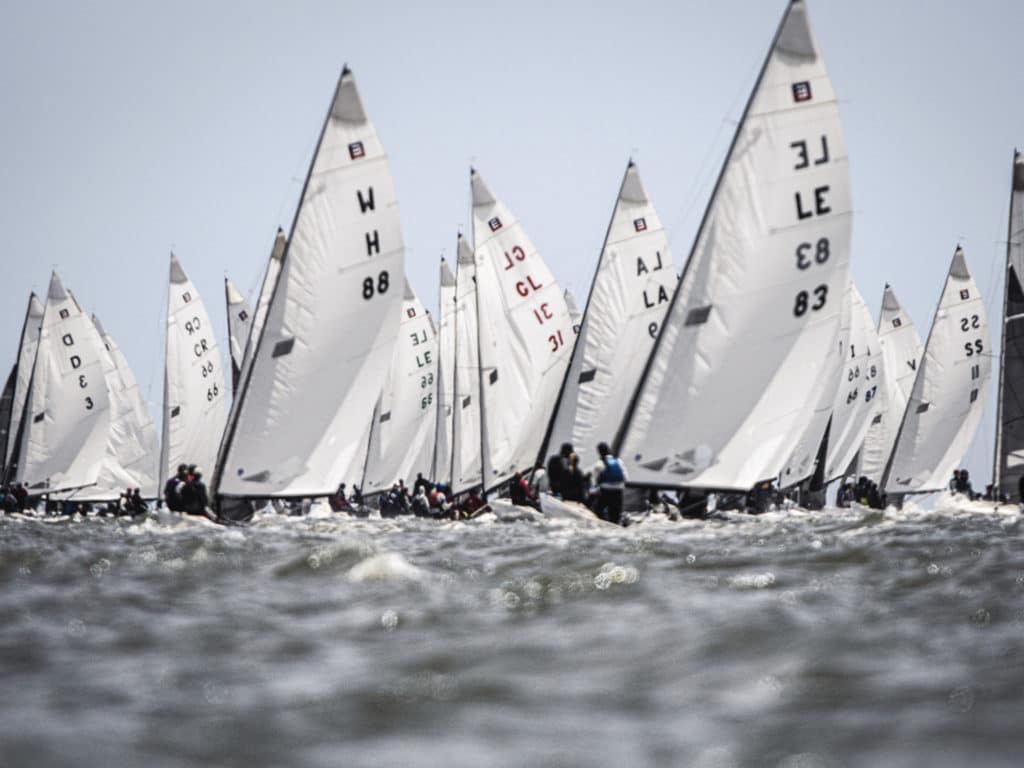
Clearly, the Melges-family speed gene continues to be passed along from one generation to the next.
“I didn’t sail with him much, but I sailed with my dad a ton,” the youngster says of his grandfather. “He learned from his dad, and it was kind of the same thing. We strive for perfect racing all the time. Perfect boat handling. Perfect boatspeed.”
Speed is one thing, but Melges says the most important thing is that the crew get along like friends. “The smoother the racing can be and talking to each other, the better it is,” he says. “My crew are so good at their jobs. We are best friends, and we have been our whole lives.”
Melges’ parents are out watching the races too. Once ashore, I ask Harry III how he helps his son. “We emphasized performance boats like the scows and Melges 15 and Melges 20,” Harry III says. “We didn’t put him in an Optimist or Club 420 program because we wanted him to learn how to tune a boat.”
Later, when I ask the younger Melges for his insight on the E Scow, he tells me: “Clear lanes are really important in these boats. And good speed is super important. We adjust our sails differently for the chop to get a little more punch in the waves. In between races, we tune the rig and adjust shrouds. We don’t do it during the race because we are full-on.”
He says the competition in the E Scow is high at the top of the fleet. “It’s the best racing in North America in my opinion,” he says, all bias aside.
Harry III adds to the discussion by explaining what helped him grow as a sailor. “So many great people would come and stay at our house,” he says. “We’d learn from those people. I remember Ben Lexcen coming to our house before the America’s Cup in 1983 and talking about his new keel design. You look back now and think, ‘Wow, pretty cool.’”
The E Scow will celebrate its 100th anniversary in 2023. It’s rare for a one-design class to endure for such an unprecedented run.
Harry III has won the E Scow National Championship seven times, so he certainly knows how to get the most from the boat. “You have to have a good feel for it,” he says. “Angle of heel on an E Scow is probably more critical than on any other kind of boat. That was one thing Buddy drove home with us. Of course, there’s also getting the boat set up correctly and spending time with your team. You have to have confidence in your maneuvers around the racecourse.”
At Little Egg Harbor, Harry III is one of dozens of great sailors currently in the fleet. Class veterans include Brian Porter, the 2013 Rolex Yachtsman of the Year and eight-time national champion. There’s also Russ Lucas, Rick Turner, 2010 National Champion Peter Hurley, Bobby Koar and Chad Hillyer.
With so much talent, it’s special to even win a race, let alone two. After the fourth race of the Little Egg Harbor championship, for example, Turner sails past the race-committee boat and announces that his second-place finish is his best score in the Nationals in 40 years. We all cheer for the accomplishment.
Porter, now 62, is still competitive and finishes fourth in this year’s championship. When asked how long he can keep going, he laughs and says, “I have my son RJ crewing for me. He is itching to take the helm away, but I am going to put it off as long as I can.”
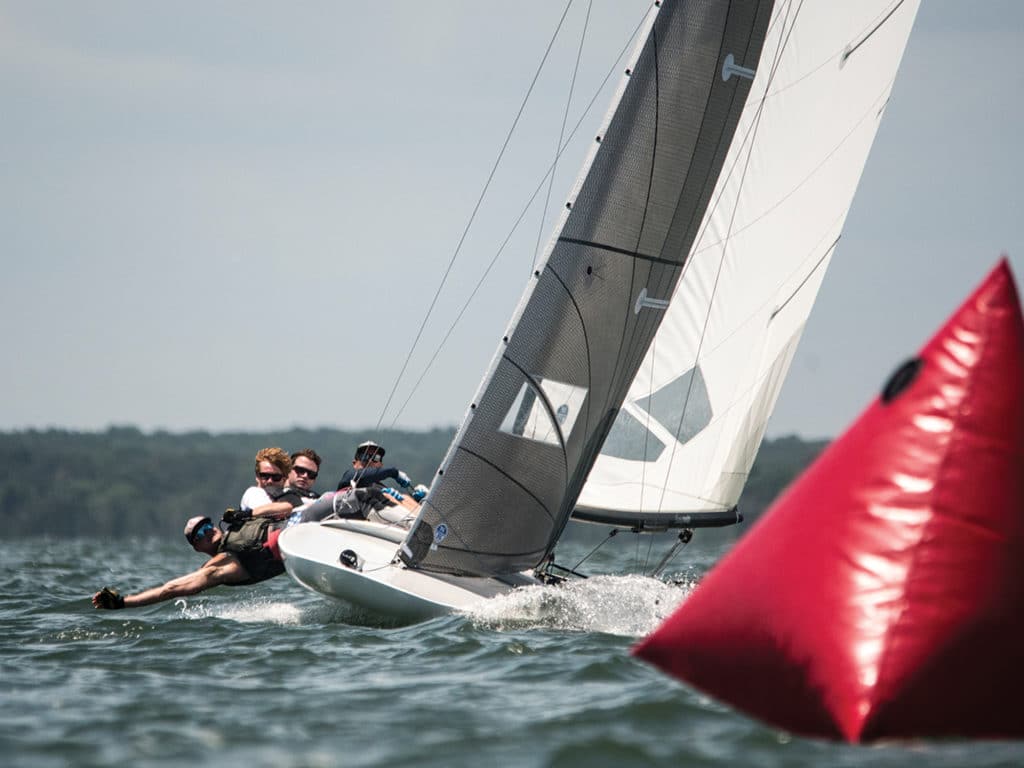
Several sailors here were top collegiate sailors and are now racing their own boats, including Harvard All-Americans Vincent Porter and Clay Johnson, as well as 2017 Rolex Yachtswoman of the Year Erika Reineke, Kyle Rogachenko and Elizabeth Tell. It is worth noting as well that 29 women raced in the championship.
The E Scow is a cross-generational family boat that will celebrate its 100th anniversary in 2023. It is rare for a one-design class to endure for such an unprecedented run, but the E Scow came about as a compromise boat between the powerful and awesome A Scow, which was impractical to move around the country, and a smaller 20-foot scow that was better-suited for two crew. The letter “E” designation was available and assigned to the new craft. It is because of the philosophy of its class founders that the E has enjoyed such a long and vibrant existence; it’s a strict one-design class, but sailors are encouraged to experiment with new innovations. Some modern examples include changing to a fixed and stayed mast rather than a rotating mast, a larger rudder, acceptance of asymmetric spinnakers, a lever boom vang, flotation in the head of the mainsail, and retractable spinnaker socks that go down the middle of the boat. A shift from wood to fiberglass hulls years ago opened the door for many more sailors. While evolution is encouraged, it’s not an arms race. The class has a robust system to approve changes. “You can request to experiment,” Harry III says. “If the board approves it, you have to submit a report. About 90 percent of these experiments get approved, which has kept the boat relevant.”
During the regatta, several sailors tell me they expect to see carbon-fiber spars sometime in the near future.
I find the names of the boats interesting. There are several that play on the “E” theme, with colorful names like TipsE , SilkE , CrazE , BloodE and In the MunE . Then there are the speed-oriented names like Full Throttle , Full Send , Full Tilt , Fast Break and Wide Open . And not to be left out, there were plenty of humorous names: Jenny No More , Route 66 , Might As Well and A Walk in the Park .
For Melges and his crew, it’s certainly not a walk in the park on their way to winning this particular championship. On the second day, they were hot with 1-3-1 finishes, but on the final day, they finished with a 15-8 to secure the win by exactly one point over Sam Rogers from Lake Minnetonka, Minnesota. Jack Brown of Barnegat Bay, New Jersey’s Seaside Park YC finished third.
The next E Scow National Championship is scheduled to sail on Torch Lake, Michigan, in September. For the sailors headed there, Buddy Melges, who is now 91 years old and has an Olympic Gold Medal and an America’s Cup victory to go with his 60 world and national titles, shares his sage advice: “You have to present the boat to Mother Nature, use the wind to your advantage, and sail more quicklier than the other boats.”
“More quicklier?” I ask him. “Is that a word?”
“You bet it is,” he responds with his typical charm, “when you’re winning.”
- More: Melges , Racing
- More Racing
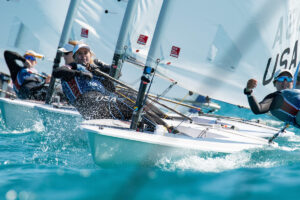
Reineke’s Battle For the Berth
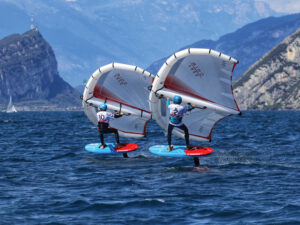
One-Design Wingfoil Racing Takes Off
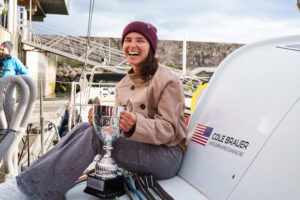
Brauer Sails into Hearts, Minds and History
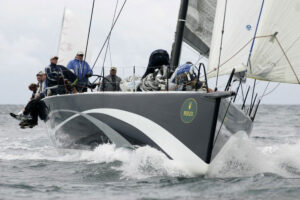
Anticipation and Temptation

America’s Offshore Couple

Jobson All-Star Juniors 2024: The Fast Generation

- Digital Edition
- Customer Service
- Privacy Policy
- Cruising World
- Sailing World
- Salt Water Sportsman
- Sport Fishing
- Wakeboarding
- New Sailboats
- Sailboats 21-30ft
- Sailboats 31-35ft
- Sailboats 36-40ft
- Sailboats Over 40ft
- Sailboats Under 21feet
- used_sailboats
- Apps and Computer Programs
- Communications
- Fishfinders
- Handheld Electronics
- Plotters MFDS Rradar
- Wind, Speed & Depth Instruments
- Anchoring Mooring
- Running Rigging
- Sails Canvas
- Standing Rigging
- Diesel Engines
- Off Grid Energy
- Cleaning Waxing
- DIY Projects
- Repair, Tools & Materials
- Spare Parts
- Tools & Gadgets
- Cabin Comfort
- Ventilation
- Footwear Apparel
- Foul Weather Gear
- Mailport & PS Advisor
- Inside Practical Sailor Blog
- Activate My Web Access
- Reset Password
- Pay My Bill
- Customer Service

- Free Newsletter
- Give a Gift

How to Sell Your Boat

Cal 2-46: A Venerable Lapworth Design Brought Up to Date

Rhumb Lines: Show Highlights from Annapolis

Open Transom Pros and Cons

Leaping Into Lithium

The Importance of Sea State in Weather Planning

Do-it-yourself Electrical System Survey and Inspection

Install a Standalone Sounder Without Drilling

When Should We Retire Dyneema Stays and Running Rigging?

Rethinking MOB Prevention

Top-notch Wind Indicators

The Everlasting Multihull Trampoline

How Dangerous is Your Shore Power?

DIY survey of boat solar and wind turbine systems

What’s Involved in Setting Up a Lithium Battery System?

The Scraper-only Approach to Bottom Paint Removal

Can You Recoat Dyneema?

Gonytia Hot Knife Proves its Mettle

Where Winches Dare to Go

The Day Sailor’s First-Aid Kit

Choosing and Securing Seat Cushions

Cockpit Drains on Race Boats

Rhumb Lines: Livin’ the Wharf Rat Life

Re-sealing the Seams on Waterproof Fabrics

Safer Sailing: Add Leg Loops to Your Harness

Waxing and Polishing Your Boat

Reducing Engine Room Noise

Tricks and Tips to Forming Do-it-yourself Rigging Terminals

Marine Toilet Maintenance Tips

Learning to Live with Plastic Boat Bits
- Sailboat Reviews
Etchells-inspired e33 – A Practical Sailor New Sailboat Review
The first-ever robbie doyle-jeremy wurmfeld collaboration balances performance sailing with basic comforts in this modern daysail boat..
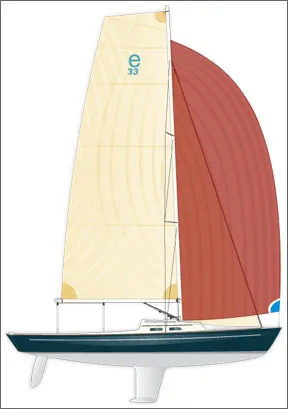
Photos courtesy of e Sailing Yachts
The trophy daysailer market is rife with branding, image, and various forms of snob appeal. The e33, however, makes its pitch on practical grounds. Reports from the field highlight the performance/comfort/control combination that makes the e33 a fun raceboat. You don’t need a big crew, you can exercise your tactical talents to the max, and you give away nothing in boatspeed. Our time sailing the e33 convinced us that it is not only a legitimate performance sailboat, but that attaining that performance is sinfully easy. The e33 daysailers bonus points include a cockpit that takes up more than half the deck space and can hold five or six adults comfortably; cockpit-led control lines; carbon-fiber spars; and a hydraulic headstay control. Below, Spartan accommodations include berths for four, an enclosed head, and a built-in cooler. With the look of a classic and the innovative design of a modern daysailer, the e33 is e Sailing Yachts intelligent, inspired, comprehensive attempt to capture the fun of performance sailing.
****
With 50 lofts in 30 countries, you might think that Robbie Doyle, founder and president of Doyle Sailmakers, would have more than enough to keep him busy. Nonetheless, hes leapt into boatbuilding. Partnered with designer Jeremy Wurmfeld, Doyle created the e33. One of the many attractive, expensive daysailers to hit the market recently, this 33-footer has minimal accommodations, a 16-foot cockpit, and a host of solutions and innovations.
Doyle remembers how the e33 came about: “Dirk Kneulman (Etchells builder and former world champion), Jeremy, and I were fantasizing about a boat that would be as much fun to sail as the Etchells without the bumps and bruises, a performance boat that could be sailed to the max with no hiking, a boat that gives you no excuse not to sail.” A college All-American (Harvard 1971), Doyle apprenticed with Ted Hood early in his career, spent significant time pursuing The America s Cup, then founded Doyle Sailmakers in 1982. “Much of my course work was in naval architecture at MIT,” he explained. That background, he asserts, not only taught him the basics of boat design, but influenced his approach to sails. Utilizing the principles of elliptical loading demonstrated in the famous Australian wing keel in 1983, Doyle became the first to apply the principle of Elliptical Aerodynamic Loading to sail shapes. The e33 thus grew out of Doyles racing experience, his feel for what sailors want, his understanding of technology, and his capacity for innovation (Stack Pack, Quicksilver reefing, etc.).
Wurmfeld was trained in conventional architecture. After a short time on the job, however, he bolted his desk to become a charter skipper in the Caribbean. After that, he came ashore to enroll in naval architecture at Westlawn Institute of Marine Technology. That degree led to a six-year stint at Sparkman & Stephens before he went out on his own in 2004. Wurmfeld also has raced Etchells on Long Island Sound for years.
Kneulman (Ontario Yachts), who builds Sonars as well as Etchells, decided not to build e33s, despite his involvement in the boats development. That led Doyle and company to Waterlines Systems of Portsmouth, R.I. Small but diversified, Waterlines has specialized in “one-design optimization” and also builds J-22s, J-24s, Farr 40s, and Mumm 30s under license. To date, the company has built more than 20 of the new boats.
The Etchells, a 30-foot, three-man keel racer introduced as a candidate for the Olympics in the mid 1960s, made a stellar starting point for the new design. Originally known as the e22 (for its waterline), the Etchells failed to be chosen for the Games despite dominating the selection trials. There are now more than 50 fleets around the world with more than 1,300 boats actively racing. Rock stars such as Dennis Conner, Jud Smith, and Dave Curtis as well as Kneulman and Doyle attest to the quality of Etchells competition. Called “eternally contemporary” and praised for tacking in 70-degrees and slipping effortlessly through the water, the boat has spawned more than its share of fanatics.
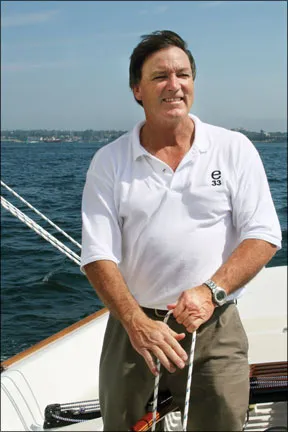
With a ballast/displacement ratio of 63 percent, Etchells are very stiff, Wurmfeld says. The e33s ballast/displacement number is 43 percent, so it, too, stands up well in a breeze. The boats narrow beam (8 feet, 6 inches) minimizes the effect of weight on the rail; the “no hiking” part of its personality is for real.
“We gave the e33 a proper bulb at the end of a 5-foot, 9-inch keel where its weight pays off,” Wurmfeld says.
Like many of the others vying for the “perfect daysailer” mantle, Doyles boat is better for being bigger. Top speed (projected at better than 10 knots) is unlocked by a generous, 27-foot waterline length. Large overhangs forward and aft help assure that its dry underway.
The biggest benefit of its bigness, though, is its huge cockpit. Deep enough to be supremely secure, it seems to go on forever. From transom to companionway, it offers uncompromised lounging, sailing, and elbow room.
The slender hull has V-sections forward of the keel for weatherliness and wave handling. Relatively slack bilges and an easy run of U-shaped sections aft strike a balance between minimizing parasitic drag and providing lift at high speed. Wurmfeld says the foils also reflect the tension between racing efficiency (deep/high-lift) and daysailing practicality (moderate draft/tracking).
One-design competition is always a possibility, but Performance Handicap Racing Fleet (PHRF) is the boats most-likely arena. It rates 90 with a cruising chute in New England and 103 without.
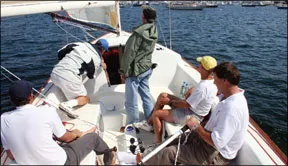
Reports from the field highlight the performance/comfort/control combination that makes the e33 fun to race. You don’t need a big crew, you can exercise your tactical talents to the max, and you give away nothing in boatspeed.
“Starting a new company, we had to beware being all things to all people,” Wurmfeld says. “But the look of the boat was critical. The relationships of masses, shapes, and angles needs to be pleasing to the eye. The counter and transom were my treatment, and Robbie had the last word on the bow angle.”
Like an Etchells, the e33 can be dry-sailed and trailered. At 5,800 pounds, its targeted for the 3-ton lifts at many yacht clubs. “You need a 300-horsepower tow vehicle,” Doyle says. “Strong points for a lifting bridle are built into the boat.”
We asked Doyle if there was a connection between the elliptical aerodynamic loading that he pioneered in the 1980s and the high-roach sailplan of the e33. “When I was building sails for Courageous back in 1977, we tried a high-roach main as an experiment. It became the only main we used that whole summer to win the Cup.”
The textbooks point out that induced drag is minimized by an elliptical (high roach) planform. That makes the ellipse or “Spitfire wing” shape the most efficient outline for a lifting surface, be it wing, keel, or sail. Certainly, sailboards and multihulls have gone heavily in the “fat-head” direction. With the advent of carbon-fiber spars (which Doyle labels “hard not to tune”), masts can now be made stiff enough to stand without a backstay. That, plus refinements in full-length batten technology let monohulls like the e33 benefit from elliptical mainsails and the efficiencies they bring.
“We resisted putting battens in our jib, but a (roller-reefable) triangle didnt give enough punch in light air,” Doyle says. Vertical battens (which make for a better-setting, more-versatile sail) let us add roach for more power.”
The e33s recessed furler with control line led to the helm affords a jib that is elegant and ergonomic as well as efficient.
“Because our sail area is more efficient, we need less of it,” says Doyle. “You can handle our jib without a winch. And our center of pressure is lower. That promotes stability. The J-100, for instance, has a mast thats 7 feet taller than ours.”
Crack off the main, and a lot of the boats sail area goes away. The sheet and traveler let you open (or close) the leech optimally via the top batten. Sails are cut full with easy-to-manage systems like the cunningham to flatten them in a breeze. If you are racing, the Sailtec hydraulic headstay assembly forms a single-point rig adjustment that you can massage puff-by-puff. If you are daysailing, you can set it and forget it.

]Not only does the deck take up half the boat, it is unbroken. More comfortable and less silly than the ubiquitous pushpit seats that adorn many of todays auxiliaries, the afterdeck affords room to read, snooze, or veg in security and comfort. If sunbathing were politically correct, you could do it there, too, all without interfering with the steering or working of the boat.
Just forward of the rudder post is a full-width traveler bar. Sited aft where toe-stubbing is no concern, its control lines are nonetheless convenient to the helm. A gracefully laminated gooseneck tiller sweeps from under the traveler forward to the helmsman.
In the center of the cockpit is a raised pod/footrest that houses mainsheet blocks and can accept a table. If you choose to have the available centerline winch, it goes there beneath the head of the tiller. The sturdy molding houses control lines (halyard, jib furler, spinnaker tackline, and self-tacking jibsheet, if you choose that option) and is low enough to be unobtrusive yet substantial enough for foot bracing. Another nice solution.
It doesn’t surprise us that a boat built by a sailmaker should emphasize sailhandling. The gross and fine-tune systems for the main are not afterthoughts. The big blocks have a home in the pod, and the little ones have been incorporated into the main (carbon-fiber) boom. Two-part control for the jib might have been cumbersome, but fairing the blocks for the fine-tuner into a cabintop channel makes the assembly look clean and work well.
Accommodations
Below, youll find “the bare necessities.” Bunks for a cozy family of four, an enclosed head, and cooler complete the list. No galley, no running water, no weight, no worries.
Doyle and his wife, Janet, took the boat on the Eastern Yacht Club cruise. In four nights and five days aboard, she enjoyed “a dry and comfortable cabin with spacious bunks … zero time over a hot stove … and having 18 aboard for cocktails in the cockpit.” Simplified, camping-out cruising has its charms. The e33 can easily provide them.
Performance

The boat has an auxiliary (a 14-horsepower Yanmar diesel with folding prop on a sail drive), but we doubt it will see much use. Open, narrow, light, and maneuverable, the e33 simplifies boathandling (under both sail and power) around docks, moorings, and marinas-an aspect of “performance” that is easily overlooked.
A 2:1 halyard and ball-bearing Ronstan cars for the battens took the strain out of raising the main. With the sail fully hoisted, the cunningham became our prime means of draft control.
The jibs conventional double-sheeting works so well that we wonder why anyone would choose the optional self-tacker. The standard 105-percent jib looks to us more hassle-free and foolproof than the self-tending alternative.
Falling off and running before a moderate souwester out of Marblehead, Mass., we noted how the jib settled into wing-and-wing untended and how comforting it was to have a clear field of vision over the bow. We sat at the rail, the seat, switched sides … there didnt seem to be a bad spot to steer from. There was nothing “corky” about the way it cut the water. There was little wobble as we surged along. Deep, narrow boats have a feel of their own.
Outside the harbor, we lost some of the breeze and picked up a bit of chop as we rounded onto the wind. This is where we expected her to be at her worst: light wind and waves. Did she have the raw sail power to punch through the slop?
With no trial horse in sight and drawing only on seat-of-the-pants approximation, we loosened the headstay and bagged the main a bit. Our acceleration improved as did our speedo numbers. While the e33 lacks the same “power reserve” you might expect from a boat with a taller rig and an overlapping headsail, its ultra-efficient rig and easily driven hull make it more competitive than you might think. An optional Code-O turbocharges the boat in light air.
On the way back to the mooring, the local “harbor hurricane” in the entrance channel bumped the breeze up into the teens. As advertised, an ease of the main and pump on the headstay had us driving through the puffs at better than 8 knots, no hiking necessary. Flat water showed her close-windedness off to advantage; tacking in less than 80 degrees was impressive.
Wending through the crowded mooring field, the e33 was balanced enough to let us bear away without spilling the main, responsive enough to carve tight turns. Several times, we approached from dead downwind and luffed around a moored boat or ball. The narrow hull carries the e33s weight for boatlengths at a time, the jib feathers harmlessly amidships. More than once, we drove to leeward around an obstacle despite a building puff … minimal helm, positive result!
Some critics called her “too much boat” for the average sailor. Others said that only top-notch pros like Doyle could get the most out of her. However, our time on the water convinced us that she is not only a legitimate “performance boat,” but that attaining that performance is sinfully easy.
Conclusions
On the printed page, the profile/sailplan of the e33 emphasizes the contrast between its modern-looking rig and its heritage hull. On the water, that mismatch is minimized to the point that we didnt find it to be a problem.
Though it doesn’t approach the “million dollar” pricetag of some of todays new daysailers, the e33 (with a base price of better than $150,000) is not cheap. But when it comes to quality items like the carbon mast and boom, you get what you pay for.
Indeed, the “trophy daysailer” market is rife with branding, image, and various forms of snob appeal. The e33, on the other hand, makes its pitch on practical grounds. As the marketing literature emphasizes, it is an intelligent, inspired, comprehensive attempt to capture the fun of performance sailing. Thanks to the talents and experience of Doyle and company, it succeeds admirably in doing just that.
- e33 Construction Details

RELATED ARTICLES MORE FROM AUTHOR
Leave a reply cancel reply.
Log in to leave a comment
Latest Videos

Island Packet 370: What You Should Know | Boat Review

How To Make Starlink Better On Your Boat | Interview

Catalina 380: What You Should Know | Boat Review
- Privacy Policy
- Do Not Sell My Personal Information
- Online Account Activation
- Privacy Manager

“The most technically accurate sailing simulator I have experienced.” SIM UK
eSail Sailing Simulator
eSail sailing simulator V2 has numerous tutorials, sailing, mooring and anchoring modes, sailing challenges, races, Live Sailing mode, ‘Learn yachting with eSail’ training course and more.
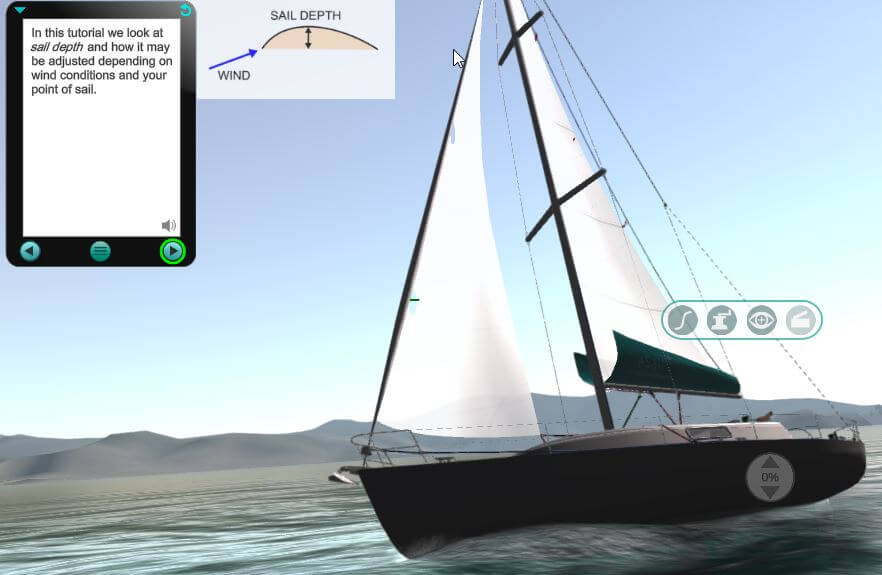
For beginners you learn how to sail a 36′ sailing yacht including raising the sail, tacking, gybing, reefing, mooring and anchoring. For experts you can use the Quick Start tutorial then dive straight into the challenges.
You can then explore the waters surrounding the Shearwater Islands and seek out features such as the wreck of the Princess Zara, and join challenges such as sailing races and collision avoidance.
Your browser does not support the video tag.
“There is a vast amount to explore and learn, the thought processes and actions required to sail your virtual boat are remarkably close to the real world.” YACHTING MONTHLY
Languages: English, Deutsch, Française, Türkçe, Español, Português, Ελληνικά, Italiano, Nederlands

The Man Overboard Add-on developed with Keith Colwell, author of the RYA Sea Survival Handbook features tutorials, challenges and random triggering of MOB during normal sailing. More…
The eSail Pro Add-on features advanced sailing instruments, mooring sandbox, mooring under sail and more…
eSail is available for Windows and Apple Mac Join the eSail community now!
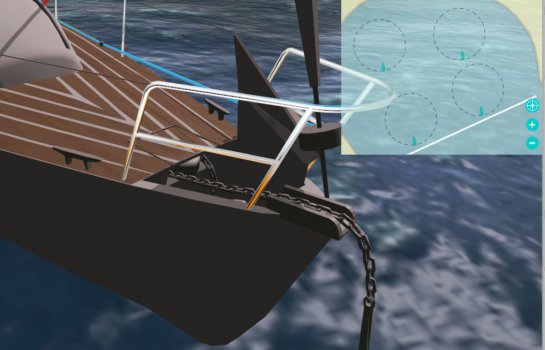
Learn Yachting with eSail
17 learning modules providing a comprehensive training course, from using the eSail controls, through to raising the mainsail, tacking, gybing and more. Use to learn to sail alongside RYA , US Sailing or other certificated training schemes.
We also have 5 advanced tutorials covering sail twist, sail depth and more, so you can squeeze every bit of speed from your virtual sailing boat. The tutorials are voiced by the amazing Hannah White, the Guinness Book of Records holder for the fastest sailing dinghy crossing of the English Channel.
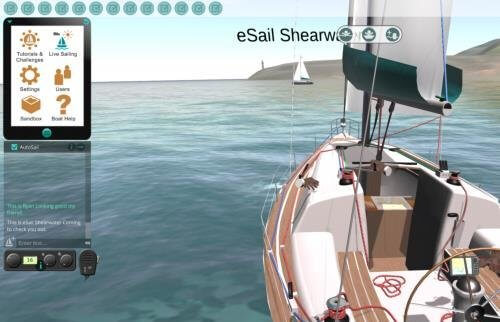
Multiplayer Live Sailing
With Live Sailing you weigh anchor, set sail and explore the seas and ocean around the Shearwater islands! Your goal is to collect ‘Points of Interest’ (POIs). If you collect all 13 you achieve ‘Master Explorer’ status.
Constantly changing weather with hourly forecasts ‘VHF’ chat with other boats Save your position Multiplayer challenges
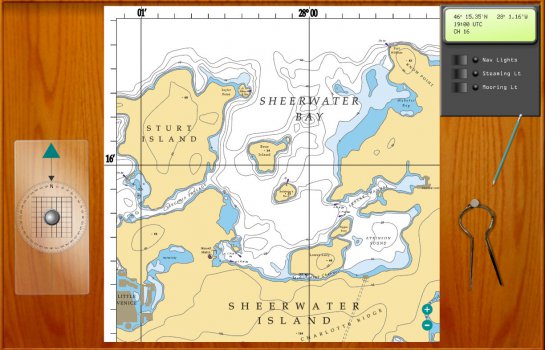
Charting & Night Sailing
To the best of our knowledge eSail is the only yacht simulator to include a charting module which enables basic navigation such as plotting a course using dividers and other charting tools. Use the chart and the lights from buoys and lighthouses to navigate.
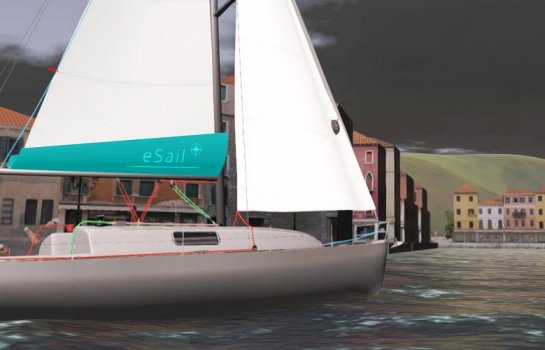
Sailing Challenges
15 challenges including Bear Island Race, Little Venice Treasure Hunt (sail through canals), collision avoidance and passage planning exercises and sailing games.
“eSail – The Sailing Simulator has raised the benchmark higher for comprehensive, fully detailed and exhaustively accurate Sailing education. Simply put the tutorials included here are brilliant!”
“If you’re new to sailing this is a fantastic way to learn at home and brush up skills. If you’re an experienced sailor then it’s still great fun and adventures can be had navigating around using charts or sailing through challengingly tight spaces!”
Practical Boat Owner
- Newsletters
- Account Activating this button will toggle the display of additional content Account Sign out
Bring On the E-Boats!
The most exciting electric vehicles in the world are for sailors only..
This is part of Airplane Mode , a series on the business—and pleasure—of travel right now.
When it comes to boats, Americans go big . Decks, hulls, interior rooms, engines—when we’re out on the water, we want to be imposing and unmissable , just like in our cars and trucks . Boats are marketed and used primarily in the United States as luxury showcases, leisure centers, and splash-happy racers—that is, for status and pleasure. It’s hard to show off that oceanside yacht, lakeside jet ski, or riverside speedboat if it looks like a speck from the shore.
That focus on size, however, has led American boaters to miss out on what may be the industry’s most exciting development over the past decade: the rise of the electric boat.
Why exciting? Because electric boats have become a proving ground for some of the most fascinating design and engineering innovations possible. There’s the French-made IZIBoat, a light sailboat that inexperienced water lovers can power with an e-bicycle , as well as the Portuguese recreation company FaroBoats, whose battery-powered models can be quickly recharged by off-grid, floating solar charging docks . Then there’s the Swedish manufacturer Candela’s combination of battery power with hydrofoiling , in which bottom-level attachments lift a vessel’s hulls out of the water in order to increase speed and distance. They also allow the e-boat to run with little in the way of splashes or noise, while ensuring a longer battery life span.
All of these examples hail from Europe, where nations have spotlighted the boating sector in their climate-change-mitigation plans. In light of the sobering fact that transportation still contributes about one-fifth of the world’s carbon emissions, and considering that shipping accounts for about 11 percent of this footprint, major European governments are pushing to decarbonize lighter vehicles in the water and on the road, with carrots and sticks aplenty. Amsterdam is banning cruise ships and phasing out all diesel versions of its tourist-beloved canal boats by 2025, while in Italy, Venice is cracking down on fossil-fueled boats and Lake Como is staging trade shows for electric boats. Meanwhile, Norway and Denmark have pioneered the use of longer-range, zero-emission public-transit ferries whose batteries can be readily recharged .
The biggest reason all of this is happening in Europe, however, comes not from government incentives, but in the fact that most of its countries have significant seafaring economies. There is plenty of boating on our side of the pond, even if you don’t live near an ocean or a Great Lake, but the industry generally isn’t so important to landlocked states. There’s also the fact that transport electrification has only taken off in the U.S. in the past few years, thanks to years of government subsidies as well as improved nationwide networks of battery- and electric-car-manufacturing hubs, renewable energy production, and accessible chargers. While the U.S. finally catches up to Europe’s electrification standards, it’s focusing mainly on land and air transport; in the meantime, some water lovers have taken it upon themselves to reembrace sail travel as a means of lowering emissions.
But when it comes to electrifying American sea vessels that would otherwise be powered by fossil fuels , there’s been scant effort from politicians across the country. Tom Hesselink, the owner of the North Carolina–based Budsin Electric Boats , thinks one of the reasons is that “the political realm thinks that boats are not a necessity, and that they shouldn’t be funding people’s luxury.” Indeed, stateside boats run purely by solar power are used mostly in races .
That’s changing, though. Through the Bipartisan Infrastructure Law, the Biden administration is delegating various funds toward electrifying public-transit ferries, hoping to expand the type of e-ferry infrastructure that’s already taken off in California. And when it comes to personal travel, some longtime American e-boat enthusiasts think it’s only a matter of time before their preferred watercraft breaks through—even as most boat buyers currently favor the less-pricey, more-traditional diesel-fueled types that overwhelmingly control the domestic market.
For its part, Budsin has been in the e-boat game since 1989. Though Hesselink told me that his company is small, “with six skilled employees building 15–20 boats per year,” he still gets to boast that he’s “the largest producer of wooden electric boats in the world”—specializing in “social boats” that “fit right in on many lakes, rivers, bays,” can hold up to 10 passengers at once, and are “absolutely quiet and pollution-free.”
“The main selling points for my boats have always been the wooden craftsmanship, their quiet nature, the ease of driving, the deep and sturdy hulls , and the affordable battery models,” Hesselink said. “And you don’t have to worry about extra maintenance, like winterizing them. In places like North Carolina, a regular outboard boat has to have the water drained out of the motor so it doesn’t freeze and break the castings, and our electric boats don’t need that.”
Hesselink acknowledges that his boats are still “niche” models for “high-end clientele”—the type who might hit up an expensive resort, see Budsin boats available for use there, and find themselves in awe of “how relaxing they are.” (They better be. Their prices range from $25,000 to $105,000.) But he’s “starting to design and market for the eco-tourism industry,” visiting countries like Mexico and the Netherlands to see how they intend to clean up their tourism sectors and figure out how he can break into their markets.
On a different scale, the San Francisco–based startup Navier is hoping to crank out e-boats that provide a basis for “small, high-speed, more frequent waterborne transportation” meant for “navigating around congested coastal cities and escaping land traffic by operating from existing marinas.” The company’s N30 model, which utilizes the same hydrofoiling design as the Swedish Candela brand and was released last year, was marketed as the first commercial-scale hydrofoil e-boat product in the U.S.—and the longest-distance e-boat in the country, with the ability to exceed a 75-nautical-mile range. That’ll certainly be an important draw for potential buyers, who often have understandable range anxiety when considering EV products.
“We are seeing a pretty steady rise in the demand for electric boats. Whether you like it or not, it’s obvious that all fossil fuel–driven vehicles will be replaced by electric transport—including boats,” Navier co-founder and CEO Sampriti Bhattacharyya told me. “But to compete, you have to meet the performance and the expectations of a traditional gas boat, which is hard to match because hydrofoiling technology requires very specialized skills, like aerospace and robotics.”
All in all, Bhattacharyya is quite bullish on her industry’s prospects, as both a climate innovation and a leap forward for boating construction. “It’s not about just making electric boats because it’s good for the environment. Here, environment and business costs go hand in hand,” she said. “Our boat is better, cheaper to operate, and easier to maintain than a gas boat. If you can build a product that is better, people will switch to that.” Bhattacharyya also pointed to her company’s investments in setting up charging infrastructure around city marinas for ease of access and use; the hope is that customers factor these benefits in should they balk at the $375,000–$550,000 price tags for Navier’s vessels.
Can more, better-quality vessels and manufacturers catapult the electric boat industry beyond its 2 percent market share in the global shipping industry? Both Hesselink and Bhattacharyya seemed confident that the worldwide push for electrified transport, and the development of technologies beyond high-in-demand, resource-intensive, weighty lithium-ion batteries would have only positive downstream effects, as e-boaters clamor for as many options as EV drivers now have. (Hesselink is particularly excited about the easy recyclability of lead-acid batteries .) Analysts of the sector predict that land-transport electrification, an increase in e-boat manufacturers, and a wider diversity of models will help to drive electric ships to become a $7.76 billion market by 2028, and a $16.6 billion industry by 2031—with plentiful and cheaper models available for all uses , from commuting to public transit to leisure to longer-term transport.
We’re still a ways away from that quieter, smaller, less-polluting e-boat bliss. But Hesselink is confident that if more people just give it a try, they’ll be ready to embrace it: “When you do a demonstration run and people push the lever, they don’t hear anything, the boat starts moving away from the dock, and the tension goes out of their body. They just relax.”

- Melges A Scow
- Melges E Scow
- Melges C Scow
- Melges MC Scow
- Melges X Boat
- O’pen Skiff
- Skeeta & Nikki
- Melges RIB 625C
- Melges Power 26
- About Melges
- Quantum Sails Zenda
- Find a Dealer
- Melges Europe
MELGES SAILBOATS
FUN. MODERN. EASY TO SAIL.
Designed by Botin Partners Naval Architecture and built by Premier Composite Technologies, the Melges 40 is a weapon for windward/leeward, inshore and coastal racing. Fresh off the design line, the Melges 40 strengthens a unique sailing/racing experience.
The Melges 32 ® is one-design racing at its best. Since 2005, it has successfully delivered bigger, better sailing that is fun and competitive. Complementing its sporty attitude, it possesses one of the most fun regatta schedules that includes many prestigious venues supported by an organized and well-established class association.
The reputation of the Melges 24 ® precedes itself. Best known for its very competitive disposition and easy-to-sail personality, this modern sportboat maintains its status as a leader in high-performance, one design yachting. With more than 850 boats sold, it continues a humbling tradition of America's Cup, Olympic Medallists, Volvo Ocean Race recruitment. Looking to improve on tactics and boat handling skills? The Melges 24 builds better sailors.
Simple, fun world-class racing at yachting's most celebrated venues. Corinthians and professionals alike. Year after year, that's what the Melges 20 Experience is all about. The Melges 20 fulfills the need for a more compact, yet spacious, fast, well-built sportboat. With its introduction, Melges Performance Sailboats delivered the next generation of sailboat racing and competition. An exclusive Reichel/Pugh keelboat design, it is advanced in every respect. Made with high-quality materials and easy to rig, the Melges 20 enjoys a well-established worldwide fleet and fan base.
Designed by Reichel/Pugh and built by Melges, the Melges 15 prioritizes stability, comfort, ease of use, and performance. The Melges 15’s stable hull shape and ergonomic cockpit make it a suitable layout for adult racing and educational sailing. Easy conversion from a club configuration (non-spinnaker) to a one-design setup, provides more versatility to club programs and options for individual owners. With the main design goals focused on stability and performance in a variety of conditions, the boat features a narrow overall beam and a flat cross-section shape for stability, righting moment, and ease of planing.
Designed by Reichel/Pugh, the Melges 14 is a modern singlehanded one-design with the ability to sail with two. With its large and open transom, there’s never a need to bail. The carbon mast and boom complement its flexible sail plan with three different size rigs. With boats in North America, Europe, Asia, Australia, and Africa, the Melges 14 is a one-design fleet for the masses. Sailors can order a custom Melges 14 dolly, easily car top it or tow it behind any vehicle. It’s a perfect beach boat, family sailboat or a one-design racing platform. It is speed, quality, durability, comfort and fun wrapped into one dynamic sailing package.
MELGES A SCOW
With six to seven crew, the A Scow is the fastest and largest of the Melges Scow family. Nothing compares to its century of heritage, delivering a combination of raw power, speed and performance unmatched in one-design sailing. A true classic, the A Scow is monumental to watch, not to mention powerful to race.

MELGES E SCOW
The elegant and super sleek Melges E Scow™ delivers an electrifying ride. The ever-growing fleet of Melges E Scows boasts both impressive world-class competition and accessible family fun for everyone. For more than 80 years, the E Scow has founded the tradition of fun and fast sailboat racing all over North America, from lakes and bays to protected ocean harbors. More than 50+ boats can be seen on the starting line.
An alternative, double-handed scow, the Melges 17 has a reputation for being fast and fun in light or heavy air. The rivalry pairings range from husband and wives to teamed siblings, making the Melges 17 the ultimate family racer!
MELGES C SCOW
The C Scow was the first class of scow built by Harry C. Melges, Sr. in 1945; it quickly became an all-time speed favorite. Inspired by more than 100 years of competitive racing, this cat-rigged, maneuverable sailboat is great fun and a total pleasure to sail. A modern, versatile and easy-to-sail boat, it accommodates 2-3 crew and is super-charged with a large, powerful mainsail. Built with integrity, the Melges C Scow™ is fast and calibrated superlatively for speed. It is one of the most friendly and popular classes in the Melges Scow family, producing as many as 80+ boats on the starting line.
An original design by the Melges family, the Melges MC is cat-rigged boat with one of the largest one-design fleets in all of North America. It is unique in the fact that you can sail single-handed or double-handed – Sailing solo is easy, taking a crew is fun! There are more than 100 fleets nationwide with more than 2,700 MCs actively racing each year.
MELGES X BOAT
The Melges X Boat® makes learning to sail fun, easy and addictive. For youth sailors, it is a rewarding experience that ultimately fosters a deep passion for the sport. Boasting a regular showing of over 100 boats at the X Inland Championship, it is one of the most active youth sailing fleets in North America. The Melges X Boat Experience not just about the racing. It’s about the community – Making lifelong friends through sailing, volleyball, and just plain fun. The Melges X Boat is the perfect, uncomplicated trainer designed specifically to be safe for novice sailors yet competitive & fun for aspiring junior racers. Fast and super smooth, it truly enables concise development and instruction of basic boat handling skills, maneuvers and racing tactics.
O’PEN SKIFF
Designed specifically for juniors, the little dinghy has blown a big breath of fresh air through our sailing world, close to the new-generation skiff concept, very fast and very simple. 100% open, self-bailing, rapid and responsive, with an up-to-date versatile rig, the O'pen Skiff offers kids a machine that delivers maximum fun while helping them learn the skills and reflexes to enjoy racing on current, high-performance equipment. Hundreds of sailing clubs around the world have opted for the O'pen Skiff, for a new, fun way of teaching sailing to appeal to youngsters attracted to new sail sports.
SKEETA & NIKKI
The Skeeta and Nikki are singlehanded foiling designs built by Jim and David French in Melbourne, AUS. The scow’s stability and ease are only further enhanced by the performance and durability of the wings and aluminum foils. Melges Performance Sailboats is the exclusive dealer for the Skeeta and the Nikki in North America.
Privacy Preference Center
Privacy preferences.
- Terms of Use
War News | Military History | Military News
E-boat: the effective german fast attack boat of the second world war.
- Military Vehicles
- World War 2
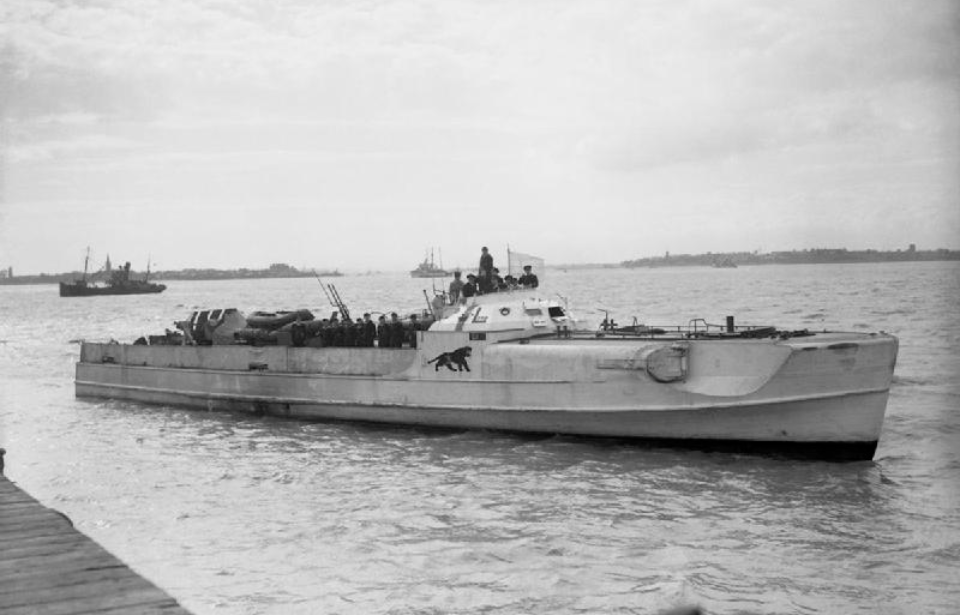
The Schnellboot – or S-Boot – was a German fast attack craft that served with the Kriegsmarine during the Second World War. It was referred to as the “E-boat” by the British, with the “E” standing for “enemy.” This became the designation used by all Allied nations. The vessel’s design evolved over the course of the conflict, with the S-100 class, the final evolution, being produced the most.
From yacht to E-boat
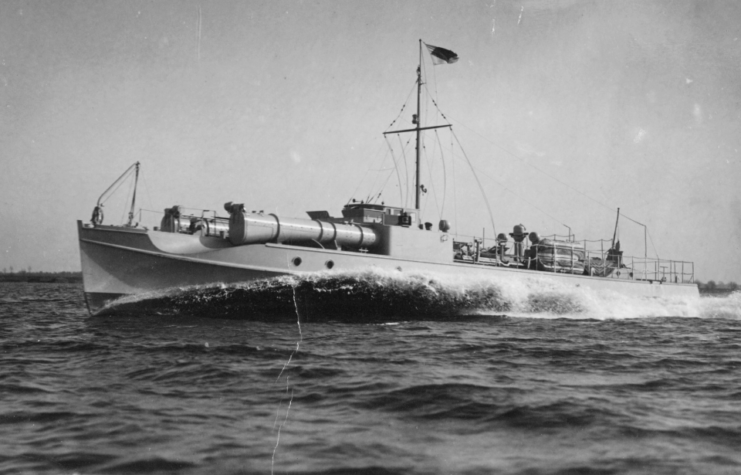
The E-boat was designed with a European war in mind. Expected to see action in the English Channel, North Sea and coastal regions, it needed to perform in rough waters. This led its design to feature a round-bottomed hull, instead of a typical flat-bottomed design. It also allowed the Germans to easily circumvent the Treaty of Versailles , which regulated large fighting ships.
The E-boat actually began life as the private yacht, Oheka II . Shipbuilding company Lürssen was contracted to produce a yacht for German-born American investment banker, Otto Hermann Kahn. The design caught the attention of the Reichsmarine , which ordered a fast attack craft with a similar design and the addition of two torpedo tubes. This became the S-1 .
Several variants were developed
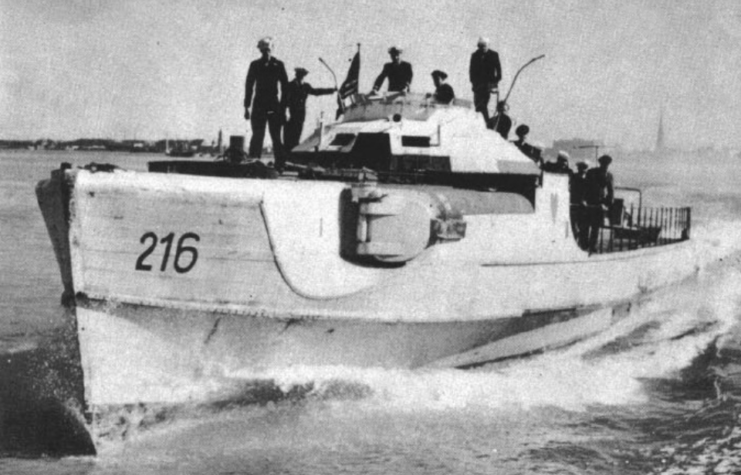
Tests were conducted with the S-1 , which resulted in various improvements made to the design. In 1931, the S-2 class became the first production model of the E-boat. These were also the first to experience combat when they were transferred to the Spanish Francoist Navy during the Spanish Civil War .
In 1933, the S-7 class was created, with seven boats produced, three of which were sold to China. The S-14 , with its longer hull, was developed the following year, followed by the S-18 in 1937. The S-26 was the first wartime model to be produced, and it entered service in 1940. This version of the E-boat featured a forward deck covering the two torpedo tubes.
The S-30 and S-38 classes followed, along with an armored type that boasted an armored bridge, as well as armament comprised of either 40 mm Bofors or 20 mm Flak anti-aircraft guns at the stern and an MG 34 Zwillingsockel at midships.
The S-100 was introduced in 1943 and was the most-produced E-boat of World War II , with 81 manufactured. The Type 700 was developed before the end of the conflict. It featured rear-facing torpedo tubes, in addition to forward facing ones, but retained the overall design of the S-100.
E-boat specs
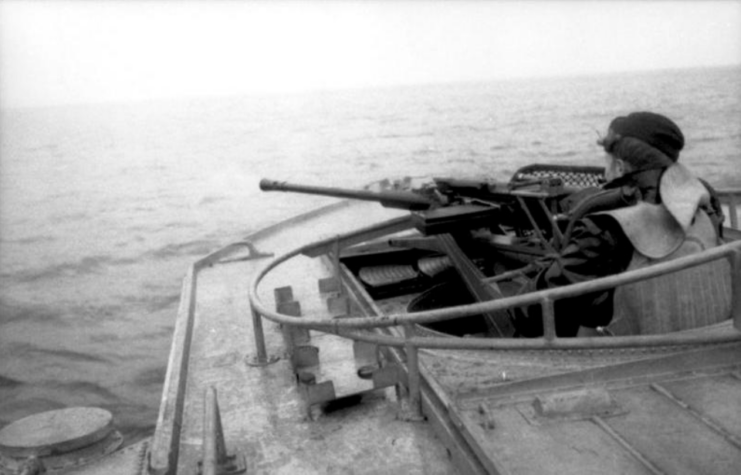
The E-boat’s hull was constructed of a metal frame and wood planks , which reduced weight for maximized speed. The S-100 class was 114.6 feet long, with a beam of 17.3 feet and a draught of 5.6 feet. The standard weight was 78.9 tons, with a maximum of 100 tons.
The E-boat design featured two small rudders on either side of the main. These could be angled outboard up to 30 degrees, which drew in an “air pocket slightly behind the three propellers, increasing their efficiency, reducing the stern wave and keeping the boat at a nearly horizontal attitude.” This was known as the Lürssen Effect. It ultimately lifted the stern of the vessel, allowing for greater speed while reducing the stern wave produced, making the E-boat harder to see.
The S-100 was powered by three Daimler Benz MB 501 marine diesel engines, which produced 3,960 brake horsepower . The E-boat had a range of 800 nautical miles at 30 knots and a maximum of 43.8 knots. It also carried a range of armament. Two 21-inch forward-facing torpedo tubes were located on either side of the bow, with four torpedoes stored onboard. It was also armed with three 20 mm C/30 cannons and one 37 mm Flak 42 cannon.
Operational history with the Kriegsmarine
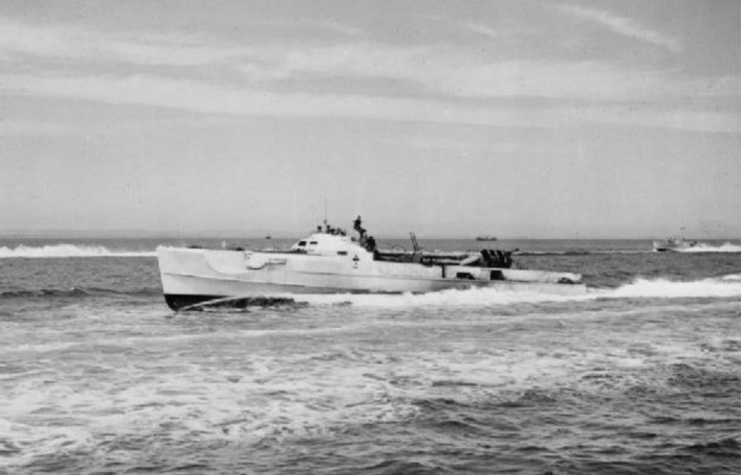
The Kriegsmarine primarily operated E-boats in the English Channel and Baltic Sea to disrupt shipping heading to southern and eastern ports. They were also deployed in smaller numbers to the Mediterranean and Black Sea – some were even used as boats aboard cruisers. E-boats deployed to the Black Sea were either transited there via river systems or dismantled and transited on land through Germany and Romania, being rebuilt upon arrival.
On April 28, 1944, E-boats with the 6th and 9th Flotillas attacked the Allied forces taking part in Exercise Tiger , one of the large-scale live-fire rehearsals for the upcoming invasion of Normandy . On D-Day itself, 31 vessels from the 9th Flotilla were the first to attack the Allied forces. At 5:00 AM, the E-boats departed Cherbourg, and, upon being confronted with the whole of the Allied fleet, fired all of their torpedoes.
E-boat accomplishments during World War II
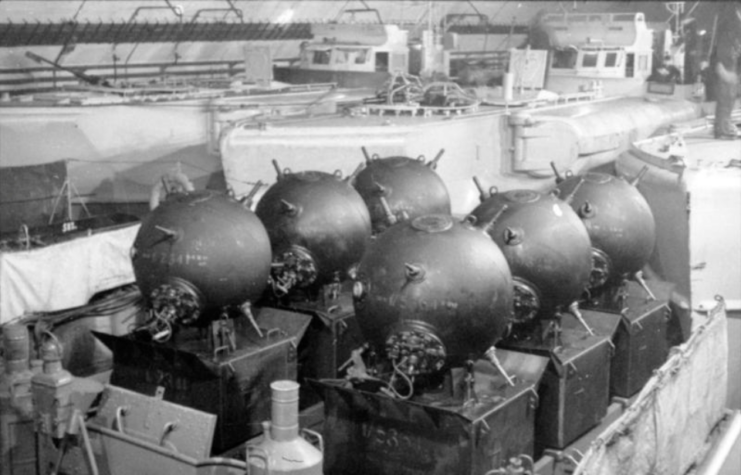
Over the course of the Second World War, E-boats reportedly sunk 12 destroyers, 11 minesweepers, eight landing ships, one submarine, six MTBs, one minelayer, one torpedo boat and various smaller vessels, including fishing boats. They were also responsible for sinking 101 Allied merchant ships, totaling 214,728 tons, and damaged various others, including two cruisers, five destroyers, three landing ships, one naval tugboat, one repair ship and several additional merchant ships.
Beyond direct action, sea mines laid by E-boats claimed 37 merchant vessels, a destroyer, two minesweepers and four landing ships. For their part in the war, 23 Knight’s Cross of the Iron Cross and 112 War Order of the German Cross in Gold were awarded to E-boat crewmen.
Das Schnellbootkriegsabzeichen – Fast Attack Craft War Badge
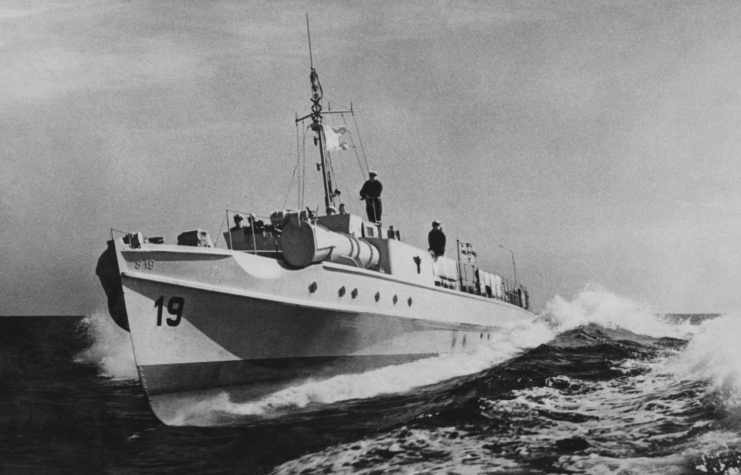
For exemplary service, crewmen serving aboard an E-boat could be awarded the Das Schnellbootkriegsabzeichen , meaning “Fast Attack Craft War Badge” or “S-Boot War Badge.” It featured a gold wreath, with the German eagle and Swastika at the top and an E-boat in the center, in silver.
More from us: Higgins Boat: The Landing Craft That Helped the Allies Win World War II
To be awarded the badge, one needed to have been involved in a distinctive mission, participated in 12 sorties against the enemy, showed good conduct and exemplary leadership, and either be wounded or killed in action (KIA).
Ultimately, the Fast Attack Craft War Badge was awarded when other decorations were unsuitable.
Great choice! Your favorites are temporarily saved for this session. Sign in to save them permanently, access them on any device, and receive relevant alerts.
- Sailboat Guide
National E (Lazy E)
National E (Lazy E) is a 15 ′ 1 ″ / 4.6 m monohull sailboat designed by Jack Holt starting in 1962.
Rig and Sails
Auxilary power, accomodations, calculations.
The theoretical maximum speed that a displacement hull can move efficiently through the water is determined by it's waterline length and displacement. It may be unable to reach this speed if the boat is underpowered or heavily loaded, though it may exceed this speed given enough power. Read more.
Classic hull speed formula:
Hull Speed = 1.34 x √LWL
Max Speed/Length ratio = 8.26 ÷ Displacement/Length ratio .311 Hull Speed = Max Speed/Length ratio x √LWL
Sail Area / Displacement Ratio
A measure of the power of the sails relative to the weight of the boat. The higher the number, the higher the performance, but the harder the boat will be to handle. This ratio is a "non-dimensional" value that facilitates comparisons between boats of different types and sizes. Read more.
SA/D = SA ÷ (D ÷ 64) 2/3
- SA : Sail area in square feet, derived by adding the mainsail area to 100% of the foretriangle area (the lateral area above the deck between the mast and the forestay).
- D : Displacement in pounds.
Ballast / Displacement Ratio
A measure of the stability of a boat's hull that suggests how well a monohull will stand up to its sails. The ballast displacement ratio indicates how much of the weight of a boat is placed for maximum stability against capsizing and is an indicator of stiffness and resistance to capsize.
Ballast / Displacement * 100
Displacement / Length Ratio
A measure of the weight of the boat relative to it's length at the waterline. The higher a boat’s D/L ratio, the more easily it will carry a load and the more comfortable its motion will be. The lower a boat's ratio is, the less power it takes to drive the boat to its nominal hull speed or beyond. Read more.
D/L = (D ÷ 2240) ÷ (0.01 x LWL)³
- D: Displacement of the boat in pounds.
- LWL: Waterline length in feet
Comfort Ratio
This ratio assess how quickly and abruptly a boat’s hull reacts to waves in a significant seaway, these being the elements of a boat’s motion most likely to cause seasickness. Read more.
Comfort ratio = D ÷ (.65 x (.7 LWL + .3 LOA) x Beam 1.33 )
- D: Displacement of the boat in pounds
- LOA: Length overall in feet
- Beam: Width of boat at the widest point in feet
Capsize Screening Formula
This formula attempts to indicate whether a given boat might be too wide and light to readily right itself after being overturned in extreme conditions. Read more.
CSV = Beam ÷ ³√(D / 64)
Seen mostly in Australia.
Embed this page on your own website by copying and pasting this code.
- About Sailboat Guide
©2024 Sea Time Tech, LLC
This site is protected by reCAPTCHA and the Google Privacy Policy and Terms of Service apply.

Looking for ez Drive ? Click here »
EZ Drive » History | 888-898-8608
- Testimonials
- · Models & Specs
- · Boat Lengths
- ezDrive Accessories
- · Simplex Thruster
- · Compact Thruster
- · Duplex Thruster
- · Powerboat Installs
- · Sailboat Installs
- · Production Photos
- · Powerboats
- · Sailboats
- E-Thrust Videos
- EZDrive Thruster
Yacht Thruster E-Thrust Overview
E-Thrust by Yacht Thruster is the world’s number one selling, externally mounted thruster for bow and stern applications, on both power and sailboats. Precision production produces a rugged housing manufactured out of solid machined aluminum with a hand built sealed motor using rare earth elements for power and durability. Since Yacht Thrusters are water cooled, they have exceptionally long continuous run-time and low battery dray.
Click below for sample installation photos:
Click below for a partial list of yacht thruster equipped brands and models:.
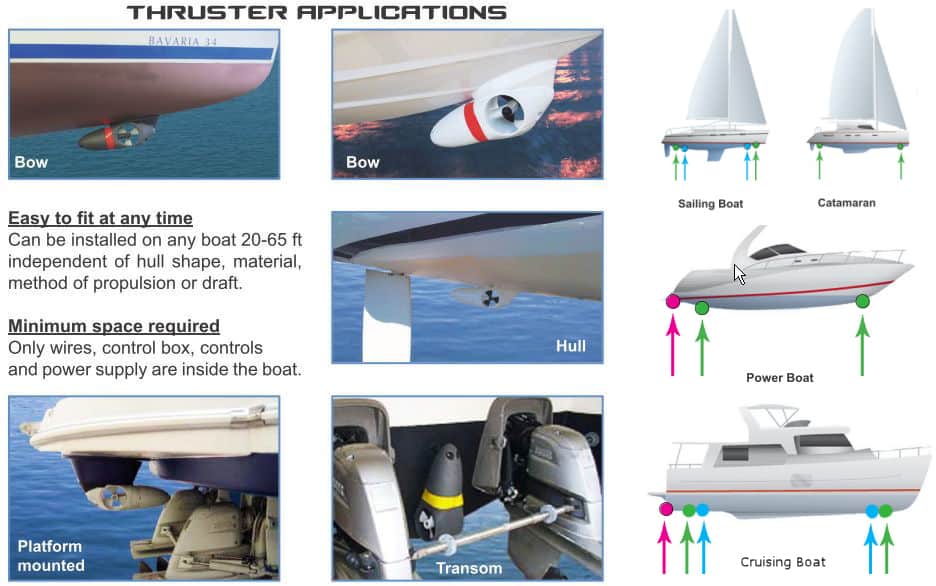
Adapter Installation
Installation of an EXTURN thruster is quick and easy. Simply drill a 50 mm diameter hole through the hull for the S/S through-hull fitting (attached to the thruster) which also feeds the required wiring. This through hull fitting is supplied with a watertight seal which eliminates the need of additional fiberglass work. Also supplied as part of the installation kit are S/S rods to be bolted through two 18 mm pre drilled holes. This also includes watertight seals and provides ultimate security and rigidity of your EXTURN thruster installation.

Mounting Bolts (Boat Interior)
The front mounting bolts are also secured from the vessels interior and provide a watertight seal.

Special Watertight Sealing
The unique seals provide a permanent watertight solution.
Sailboat Installation Positioning
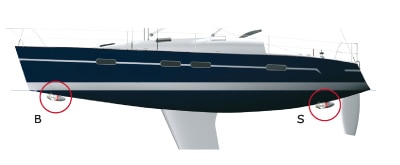
Optimal position for EXTURN installations: Bow Thruster (B) Stern Thruster (S)
On round chines there is no/limited necessary GRP work.
Powerboat Installation Positioning
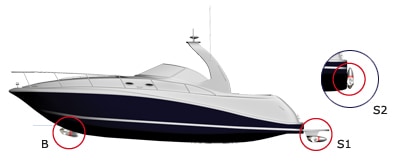
Optimal position for EXTURN installations: Bow Thruster (B) Stern Thruster under swim platform (S1) Stern Thruster on “vertical transom” (S2)
On hard chines a fiberglass adaptor may be necessary for installation.
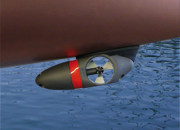
EXTURN as Bow Thruster
Jeanneau 42
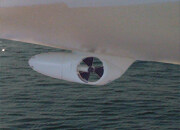
EXTURN as Stern Thruster
Crownline 250
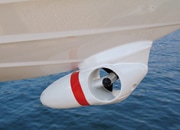
EXTURN as Bow Thruster with fiberglass adaptor
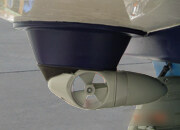
EXTURN as Stern Thruster with adaptor under swim platform


- Collegiate Boats

Call for Pricing
Write a Review

- Create New Wish List
Click Here to Request a Quote!
The 420E from Zim Sailing sets a new standard in enclosed deck technology for high school and college sailing. The airtight foredeck has taken weight out of the bow, increasing performance and safety, without sacrificing the durability Zim Sailing's boats are known for. Institutions such as high schools, colleges, and community sailing programs, demand a unique combination of performance and toughness, and the 420E delivers.
Hull and Deck
- All thru deck mounted hardware is supported by tapped aluminum backing plates glassed to the inside of the boat which eliminate inspection ports.
- Enclosed foredeck so water does not flow to the bow which will increase safety and provide greater performance.
- Forestay chain plate, extruded aluminum with three ¼” fasteners thru bolted into an aluminum backing plate which add durability and strength to the boat.
- Shroud chain plate is a forged eye strap supported with an aluminum back-up bar under the rail for additional durability.
- Jib leads have been moved 4 inches inboard to eliminate inboard sheeting and promote a higher pointing angle.
- All flanges and hull to deck joints are bonded with Plexus methyl methacrylate structural adhesive to eliminate leaks and hull/deck separation. This is the strongest bonding agent on the market and Zim is the only company to use this to bond their boats.
- Keelson rib is solid and laminated to the aft end of the centerboard trunk to strengthen the hull when loaded with water and pulled onto the dock which will prevent the boat from buckling which cause stress cracks on the hull.
- Keelson rib height has been increased to provide the perfect platform for skippers to step across the boat for perfect maneuvers.
- Elastomeric urethane bow bumpers are the industry standard for increased durability.
- One-piece high density urethane gasket retainer with cloth gaskets to increased durability and allow for easy maintenance.
- Reinforced mast partner
- Harken 75mm carbo mainsheet blocks and jib sheet cleats will provide increased reliability.
- Heavy Duty transom pintles are the longest lasting pintles on the market and the rudder retainer clip has a plastic tip to eliminate pinching fingers. The rudder comes with a lanyard to secure it to the boat.
- Tennis ball transom bailer is connected to an eye strap on the keelson for easy closure.
- 6:1 Harken vang system which allows for easy adjustment.
- Horn cleat for the aft hiking strap will provide easy adjustment between sets.
- Jib tack quick pin with lanyard to eliminate pins being dropped in water.
- Heavy duty webbing hiking straps for greater longevity.
- FJ rudder promotes less drag and while providing more pointing.
- Dwyer mast.
- Selden boom with drilled and tapped screws to prevent block movement
- External outhaul.
- Selden boom gooseneck spigot is permanently attached to the boom
Base Boat Includes
- Zim Platinum sails with team race graphics and program logo up to 1sq meter and 3 colors
- Dwyer mast and Selden boom
- Recessed gasket
- Tennis ball bailer – Double
- Vinyl bow number
- Filled stern rails
- Lanyard to attached drain plugs
- Marlow line package
*Boat price doesn't include freight from Zim Sailing to Customer
Related Products

North Sails
420E Hiking Strap

FJ/420E Rudder - Gray

FJ / 420E Rudder - White

Dwyer Mast & Rigging
Base, 420E Vang Cleat
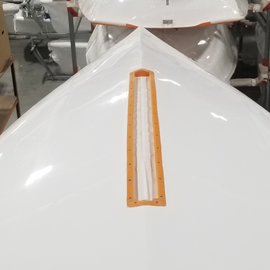
420 SCV / 420E Gasket Retainer Molded

The Ultimate Guide to Choosing Between a Sailboat or Catamaran for Your Sailing Adventures
C hoosing between a sailboat and a catamaran for your sailing adventures is a significant decision that depends on various factors, including your sailing preferences, experience level, budget, and intended use. Here's an ultimate guide to help you make an informed decision:
1. Sailing Experience:
- Sailboats: Typically require more skill and experience to handle, especially in adverse weather conditions. Ideal for sailors who enjoy the traditional feel of sailing and are willing to invest time in learning and mastering the art.
- Catamarans: Easier to handle, making them suitable for beginners. The dual-hull design provides stability, reducing the learning curve for those new to sailing.
2. Space and Comfort:
- Sailboats: Generally have a narrower beam and less living space. However, some sailboats may offer comfortable cabins and amenities.
- Catamarans: Wider beam creates more living space. Catamarans often have multiple cabins, spacious saloons, and expansive deck areas, providing a more comfortable living experience.
3. Stability:
- Sailboats: Monohulls can heel (lean) while sailing, which some sailors enjoy for the thrill but can be discomforting for others.
- Catamarans: Greater stability due to the dual hulls, providing a more level sailing experience. Reduced heeling makes catamarans suitable for those prone to seasickness.
4. Performance:
- Sailboats: Known for their upwind performance and ability to sail close to the wind. Some sailors appreciate the challenge of optimizing sail trim for efficiency.
- Catamarans: Faster on a reach and downwind due to their wide beam. However, they may not point as high into the wind as monohulls.
- Sailboats: Typically have a deeper draft, limiting access to shallow anchorages and requiring deeper marina berths.
- Catamarans: Shallow draft allows access to shallower waters and secluded anchorages, providing more flexibility in cruising destinations.
- Sailboats: Generally more affordable upfront, with a wide range of options available to fit different budgets.
- Catamarans: Often more expensive upfront due to their size and design. However, maintenance costs may be comparable or even lower in some cases.
7. Mooring and Docking:
- Sailboats: Easier to find slips and moorings in marinas designed for monohulls.
- Catamarans: Require wider slips and may have limited availability in certain marinas, especially in crowded anchorages.
8. Intended Use:
- Sailboats: Ideal for traditional sailors who enjoy the art of sailing, racing enthusiasts, or those on a tighter budget.
- Catamarans: Suited for those prioritizing comfort, stability, and spacious living areas, especially for long-term cruising and chartering.
9. Resale Value:
- Sailboats: Generally have a more established resale market, with a wider range of buyers.
- Catamarans: Growing in popularity, and well-maintained catamarans often retain their value.
10. Personal Preference:
- Consider your personal preferences, the type of sailing you plan to do, and the kind of lifestyle you want aboard your vessel.
In conclusion, both sailboats and catamarans have their advantages and disadvantages. Your decision should be based on your individual preferences, experience level, budget, and intended use. If possible, charter both types of vessels to experience firsthand how they handle and to help make a more informed decision based on your own preferences and needs.
The post The Ultimate Guide to Choosing Between a Sailboat or Catamaran for Your Sailing Adventures appeared first on Things That Make People Go Aww .


Sailboat Rig Dimensions: E
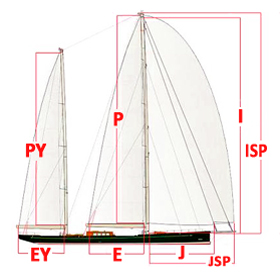
- Election 2024
- Entertainment
- Newsletters
- Photography
- AP Buyline Personal Finance
- Press Releases
- Israel-Hamas War
- Russia-Ukraine War
- Global elections
- Asia Pacific
- Latin America
- Middle East
- March Madness
- AP Top 25 Poll
- Movie reviews
- Book reviews
- Personal finance
- Financial Markets
- Business Highlights
- Financial wellness
- Artificial Intelligence
- Social Media
Three people were rescued after a sailboat caught fire off the coast of Virginia Beach
Emergency personnel try to put a fire on a sailboat off the coast of Cape Henry, Va. early Friday, March 8, 2024. Three people were rescued as the U.S. Coast Guard asked the Virginia Beach Fire Department’s fire boat crews to help respond to the fire about 3 miles (4.8 km) off the coast of Cape Henry around 3:40 a.m., department spokesperson said in an email. (Virginia Beach Fire Department via AP)
- Copy Link copied
VIRGINIA BEACH, Va. (AP) — Three people were rescued after a sailboat caught fire off the coast of Virginia Beach early Friday, a fire official said.
The U.S. Coast Guard asked the Virginia Beach Fire Department’s fire boat crews to help respond to the fire about 3 miles (4.8 km) off the coast of Cape Henry around 3:40 a.m., department spokesperson Barbara Morrison said in an email.
A pilot boat picked up the three adults after they jumped into the water from the 75-foot (22.9-meter) sailboat and they were taken to the nearby Virginia pilot house, Morrison said. EMS checked out the patients and no injuries were reported, she said.
- United States
- Fort Lauderdale
Best Winery Restaurants in Sailboat Bend
7 restaurants available nearby, 1. fleming’s steakhouse - fort lauderdale, 2. the capital grille - ft. lauderdale, 3. seasons 52 - ft. lauderdale, 4. cooper's hawk winery & restaurant - dania beach, 5. sapido italian restaurant, pizza , wine , market and café, 6. farraddays steakhouse at harrah’s pompano beach, 7. uptown keese`s greek cuisine.
Explore OpenTable
- Sailboat Bend
- Tarpon River
- Coral Ridge
- Lauderdale Beach
- Lauderdale Lakes
- Poinsettia Heights
- Colee Hammock
- Coconut Creek
- Flagler Village
- Dania Beach
- Victoria Park
- Melrose Manors
- Dining Rewards
- Private Dining
- Reserve for Others
- Restaurants Near Me
- Delivery Near Me
- Restaurants Open Now
- OpenTable for iOS
- OpenTable for Android
- Affiliate Program
- OpenTable.jp
- OpenTable.de
- OpenTable.es
- OpenTable.ca
- OpenTable.hk
- OpenTable.ie
- OpenTable.sg
- OpenTable.nl
- OpenTable.com.mx
- OpenTable.co.uk
- OpenTable.com.au
- OpenTable.ae
- OpenTable.co.th
- OpenTable.it
- OpenTable.com.tw
- OpenTable.fr
- Restaurant reservation software
- Industry insights
- Hospitality resources
- Marketing resources
- Operation resources
- How to open a restaurant
- For restaurants
- For restaurant groups
- Privacy Policy
- Terms of Use
- Cookies and Interest-Based Ads
- Do Not Sell or Share My Personal Information
- Cookie Preferences

- Weather
Search location by ZIP code
Coast guard rescues 72-year-old man from sinking sailboat 185 miles off fort myers coast.
- Copy Link Copy {copyShortcut} to copy Link copied!

GET LOCAL BREAKING NEWS ALERTS
The latest breaking updates, delivered straight to your email inbox.
A Coast Guard aircrew rescued a 72-year-old man from a sailboat that was sinking in the Gulf of Mexico on Friday, 185 miles west of Fort Myers.
According to the U.S. Coast Guard Southeast , helicopter and airplane crews spotted the man in his 40-foot boat at around 12 p.m.
The helicopter lifted the man from the sinking sailboat and he was taken to Tampa Fire Rescue emergency medical services at Peter O. Knight Airport to receive a higher level of care.

- My Wishlist
- United States
- Sets by theme
- Price Ranges
- LEGO Merchandise
- Pick and Build
- Bestsellers
- Offers & Sale
- Coming Soon
- Find inspiration
- Last Chance to Buy
- Architecture
- Botanical Collection New
- Creator 3in1
- Creator Expert
- Harry Potter™
- Jurassic World
- LEGO® Animal Crossing™ New
- LEGO® Avatar
- LEGO® Braille Bricks New
- LEGO® DREAMZzz™
- LEGO® DUPLO® Peppa Pig New
- LEGO® Education
- LEGO® Gabby's Dollhouse
- LEGO® Icons
- LEGO® Indiana Jones™
- LEGO® Super Mario™
- Lord of the Rings™
- Minifigures
- Monkie Kid™
- SERIOUS PLAY®
- Sonic the Hedgehog™
- Speed Champions
- Star Wars ™
- Accessories
- LEGO® Throw Blankets New
- Lunch Boxes
- Puzzles & Board games
- Role Play & Costumes
- Video Games
- LEGO® Water Bottles
- Adults Welcome
- Arts and Crafts
- Coding for Kids
- Learn to build
- Real-Life Heroes
- Robots for Kids
- Pick a Brick
- Brick Accessories & Kits
- Minifigure Factory
- Our Magazines
- Black Friday Livestream
- All LEGO Themes
- All LEGO Interests
- Looking For a Gift?
- For Families
- LEGO® Fortnite®
- LEGO® Insiders
- LEGO® Mosaic Maker
- LEGO® Gift Ideas
- Sustainability
- LEGO Builder
- LEGO Life App
- LEGO Catalogs
- FREE LEGO Life Magazine
- Check Order Status
- Delivery & Returns
- Find a LEGO Store
- Find Building Instructions
- Common Questions
- Replacement Parts
Easter Sale, 3/12-3/21* Shop now
Spring Garden House gift with purchases of $80 or more* Learn more
Sweet bunny gift with purchases of $40 or more* Learn more
FREE Shipping with orders over $35!* Learn more
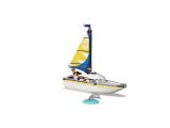
Available now
We restrict the limit a household can buy in order to be fair to all of our fans. If you’ve already reached that limit through previous orders your entire order may be cancelled.
Become a LEGO® Insider!
Time to set sail, a fun build-and-sail toy for ages 5+, lego® city sailboat, elegant design.
Check out the tall mast and printed sail.
Welcome aboard
Includes a boat’s wheel and a cozy cabin with a bed.
Characters for creative play
Fun adventures with 2 minifigures and a dolphin figure.
Enter a digital world of building
A treat for sailing fans, specifications, customer reviews.

IMAGES
VIDEO
COMMENTS
THE MELGES E SCOW. The elegant and sleek Melges E Scow is the pinnacle of high speed one-design racing for sailors in North America, from lakes and bays to protected ocean harbors. With over 70 boats regularly hitting the starting line at the National Championship, the Melges E Scow is an ever-growing fleet driven by a design that's always ...
The National Class E-Scow Association (NCESA) was founded in 1959 to promote the sport of E-Scow Racing. It exists to serve all regions of the country where E-Scow Sailing is pursued. There are three types of membership in the NCESA: Boat Owner - Regular - Associate. The NCESA is supported through membership dues, we are 501c3 non-profit ...
Notes. This from designer Julian Everitt: "E Boat was originally designed as an offshore one design and predates the mini ton, but happens to be the right size as it was conceived to be the smallest that would measure under the IOR rule." (Plans are still available through class web site.) Original Builder: Evolution Yachts Ltd. Other builders:
E Boat (Everitt) is a 21′ 11″ / 6.7 m monohull sailboat designed by Julian Everitt and built by Evolution Yachts Ltd. (UK)/Vela 77 (ITA) between 1974 and 2009.
Family Daysailer, classically inspired, light air and downwind power, single-handed ease, thoroughbred performance undersail and under power
Officially launched in 1924, the 28-foot E Scow was an answer to the much harder to manage 38-foot A Scows that began sailing in Minnesota in 1900, and the single-sail, 20-foot C Scow that was usually used for training. Typically sailed with a crew of three or four, the boat's sail plan has changed over time, but today it is sloop-rigged with ...
After 7 years of constant improvements, the latest version - the e33LM - is a revolutionary hybrid boat using a wood/glass combination that maintains our vision of the ultimate daysailer. With high level engineering coupled with our top composite team, e Sailing Yachts has entered a new generation of truly elegant performance boats that are ...
E-boat was the Western Allies' designation for the fast attack craft (German: Schnellboot, or S-Boot, meaning "fast boat"; plural Schnellboote) of the Kriegsmarine during World War II; E-boat could refer to a patrol craft from an armed motorboat to a large Torpedoboot. The name of E-boats was a British designation using the letter E for Enemy.. The main wartime production boats, from S26 ...
The E Scow is a cross-generational family boat that will celebrate its 100th anniversary in 2023. It is rare for a one-design class to endure for such an unprecedented run, but the E Scow came ...
E Scow is a 27′ 11″ / 8.5 m monohull sailboat designed by Arnold Meyer Sr and built by Johnson Boat Works and Melges Performance Sailboats starting in 1924.
Open, narrow, light, and maneuverable, the e33 simplifies boathandling (under both sail and power) around docks, moorings, and marinas-an aspect of "performance" that is easily overlooked. A 2:1 halyard and ball-bearing Ronstan cars for the battens took the strain out of raising the main.
eSail Sailing Simulator. eSail sailing simulator V2 has numerous tutorials, sailing, mooring and anchoring modes, sailing challenges, races, Live Sailing mode, 'Learn yachting with eSail' training course and more. For beginners you learn how to sail a 36′ sailing yacht including raising the sail, tacking, gybing, reefing, mooring and ...
The boat is supported by an active class club that organizes racing events, the National Class E Scow Association. By 1994 racing fleets were sailing in Texas, Colorado, Wisconsin, Minnesota, Michigan, New York and New Jersey. In a 1994 review Richard Sherwood wrote, "this is a very fast and sophisticated boat with a long history of development.
The E-Boat was designed by Julian Everitt and went into production in 1976. There were in excess of 250 E-Boats built between 1976 and 1984, around one hundred and fifty of which were in the UK. It was designed to comply with IOR rules and is a 22 feet, four berth trailer sailer.The E-Boat Offshore One Design is a light displacement flush deck IOR Mini Ton keel-boat with a lifting cast iron ...
Analysts of the sector predict that land-transport electrification, an increase in e-boat manufacturers, and a wider diversity of models will help to drive electric ships to become a $7.76 billion ...
The ever-growing fleet of Melges E Scows boasts both impressive world-class competition and accessible family fun for everyone. For more than 80 years, the E Scow has founded the tradition of fun and fast sailboat racing all over North America, from lakes and bays to protected ocean harbors. More than 50+ boats can be seen on the starting line.
The E-boat design featured two small rudders on either side of the main. These could be angled outboard up to 30 degrees, which drew in an "air pocket slightly behind the three propellers, increasing their efficiency, reducing the stern wave and keeping the boat at a nearly horizontal attitude." This was known as the Lürssen Effect. It ultimately lifted the stern of the vessel, allowing ...
E Scow (National Class E Scow Association) Download Boat Record: Notes. Main: 228 sq.ft. Jib: 95 sq.ft. Spinnaker: 550 sq.ft. Sailboat Forum. ... The maximum speed of a displacement hull (referring to a hull that travels through the water rather than on top of it, e.g. planing). HS = 1.34 x √LWL (in feet) Pounds per Inch Immersion:
National E (Lazy E) is a 15′ 1″ / 4.6 m monohull sailboat designed by Jack Holt starting in 1962. Great choice! Your favorites are temporarily saved for this session. ... It may be unable to reach this speed if the boat is underpowered or heavily loaded, though it may exceed this speed given enough power. Read more. Formula.
Yacht Thruster E-Thrust Overview. E-Thrust by Yacht Thruster is the world's number one selling, externally mounted thruster for bow and stern applications, on both power and sailboats. Precision production produces a rugged housing manufactured out of solid machined aluminum with a hand built sealed motor using rare earth elements for power ...
The 420E from Zim Sailing sets a new standard in enclosed deck technology for high school and college sailing. The airtight foredeck has taken weight out of the bow, increasing performance and safety, without sacrificing the durability Zim Sailing's boats are known for. Institutions such as high schools, colleges, and community sailing programs ...
Choosing between a sailboat and a catamaran for your sailing adventures is a significant decision that depends on various factors, including your sailing preferences, experience level, budget, and ...
Sailboat Rig Dimensions: E. EL - EN - ER - ET - EV. Definitions: I = Height of headstay termination above the sheer line. J = Distance between the headstay termination at the deck and the front of the mast at the sheer line. P = Distance between black bands on the mast, or the maximum luff length of the main. E = Distance between black bands on ...
Emergency personnel try to put a fire on a sailboat off the coast of Cape Henry, Va. early Friday, March 8, 2024. Three people were rescued as the U.S. Coast Guard asked the Virginia Beach Fire Department's fire boat crews to help respond to the fire about 3 miles (4.8 km) off the coast of Cape Henry around 3:40 a.m., department spokesperson said in an email.
The Chicago Boat Show, long a winter attraction at McCormick Place, is leaving the city and setting sail for the Donald E. Stephens Convention Center in Rosemont next year.
Best French / Indian Restaurants in Sailboat Bend. Find a table. Filter (0) Price $$ $$ Price: Moderate (114) $$$ $ Price: Expensive (79) $$$$ Price: Very Expensive (25) 3 restaurants available nearby. 1. La Parisienne Chic Cafe & Lounge new $$ $$ Price: Moderate • French indian • Central Beach.
Best Winery Restaurants in Sailboat Bend. Find a table. Filter (0) Price $$ $$ Price: Moderate (114) $$$ $ Price: Expensive (79) $$$$ Price: Very Expensive (25) 7 restaurants available nearby. 1. Fleming's Steakhouse - Fort Lauderdale. 4.5. Awesome $$$ $ Price: Expensive • Winery • Downtown.
A Coast Guard aircrew rescued a 72-year-old man from a sailboat that was sinking in the Gulf of Mexico on Friday, 185 miles west of Fort Myers.According to the U.S. Coast Guard Southeast ...
This article details the qualifying phase for sailing at the 2024 Summer Olympics.312 quota places for the Games are entitled to the sailors coming from their respective NOCs, based on the results at designated regattas supervised by World Sailing.Host nation France reserves a single boat in each of the ten sailing classes, whereas four quota places (two per gender) are distributed to the NOCs ...
Little sailors will love this playset, featuring a toy sailboat, plus 2 minifigures and a dolphin figure. Play. A fun build-and-sail toy for ages 5+ Kids enjoy an immersive building experience before joining the crew for exciting sailing adventures. LEGO® City Sailboat. Elegant design.